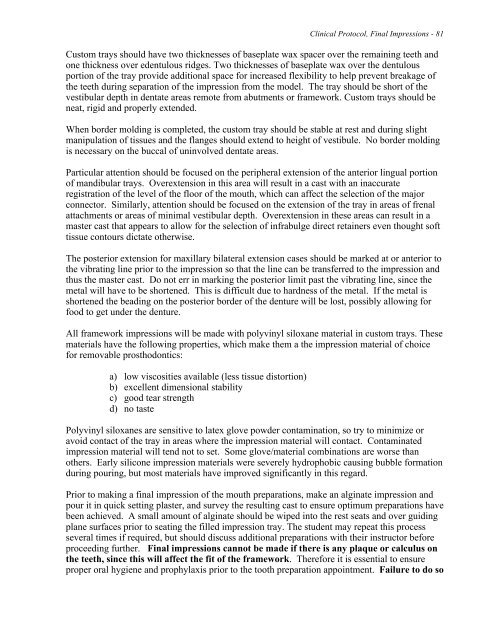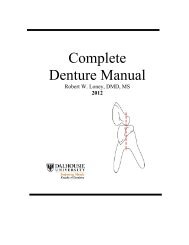RPD Manual 11 - Removable Prosthodontics - Dalhousie University
RPD Manual 11 - Removable Prosthodontics - Dalhousie University
RPD Manual 11 - Removable Prosthodontics - Dalhousie University
Create successful ePaper yourself
Turn your PDF publications into a flip-book with our unique Google optimized e-Paper software.
Clinical Protocol, Final Impressions - 81<br />
Custom trays should have two thicknesses of baseplate wax spacer over the remaining teeth and<br />
one thickness over edentulous ridges. Two thicknesses of baseplate wax over the dentulous<br />
portion of the tray provide additional space for increased flexibility to help prevent breakage of<br />
the teeth during separation of the impression from the model. The tray should be short of the<br />
vestibular depth in dentate areas remote from abutments or framework. Custom trays should be<br />
neat, rigid and properly extended.<br />
When border molding is completed, the custom tray should be stable at rest and during slight<br />
manipulation of tissues and the flanges should extend to height of vestibule. No border molding<br />
is necessary on the buccal of uninvolved dentate areas.<br />
Particular attention should be focused on the peripheral extension of the anterior lingual portion<br />
of mandibular trays. Overextension in this area will result in a cast with an inaccurate<br />
registration of the level of the floor of the mouth, which can affect the selection of the major<br />
connector. Similarly, attention should be focused on the extension of the tray in areas of frenal<br />
attachments or areas of minimal vestibular depth. Overextension in these areas can result in a<br />
master cast that appears to allow for the selection of infrabulge direct retainers even thought soft<br />
tissue contours dictate otherwise.<br />
The posterior extension for maxillary bilateral extension cases should be marked at or anterior to<br />
the vibrating line prior to the impression so that the line can be transferred to the impression and<br />
thus the master cast. Do not err in marking the posterior limit past the vibrating line, since the<br />
metal will have to be shortened. This is difficult due to hardness of the metal. If the metal is<br />
shortened the beading on the posterior border of the denture will be lost, possibly allowing for<br />
food to get under the denture.<br />
All framework impressions will be made with polyvinyl siloxane material in custom trays. These<br />
materials have the following properties, which make them a the impression material of choice<br />
for removable prosthodontics:<br />
a) low viscosities available (less tissue distortion)<br />
b) excellent dimensional stability<br />
c) good tear strength<br />
d) no taste<br />
Polyvinyl siloxanes are sensitive to latex glove powder contamination, so try to minimize or<br />
avoid contact of the tray in areas where the impression material will contact. Contaminated<br />
impression material will tend not to set. Some glove/material combinations are worse than<br />
others. Early silicone impression materials were severely hydrophobic causing bubble formation<br />
during pouring, but most materials have improved significantly in this regard.<br />
Prior to making a final impression of the mouth preparations, make an alginate impression and<br />
pour it in quick setting plaster, and survey the resulting cast to ensure optimum preparations have<br />
been achieved. A small amount of alginate should be wiped into the rest seats and over guiding<br />
plane surfaces prior to seating the filled impression tray. The student may repeat this process<br />
several times if required, but should discuss additional preparations with their instructor before<br />
proceeding further. Final impressions cannot be made if there is any plaque or calculus on<br />
the teeth, since this will affect the fit of the framework. Therefore it is essential to ensure<br />
proper oral hygiene and prophylaxis prior to the tooth preparation appointment. Failure to do so















